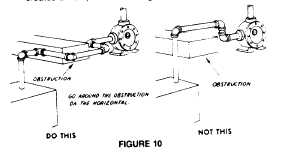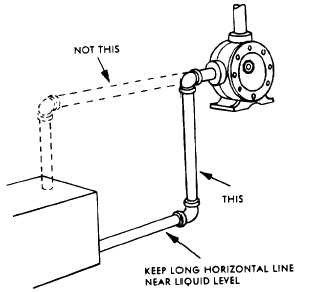TM 5-3895-374-24-2
4.
When approaching an obstacle in the suction or
discharge line, go around the obstacle instead of over
it. Going over it creates an air Docket. See Figure
10.
5.
Where practical, slope the piping so no air or liquid
pockets will be formed. Air pockets in the suction line
make it hard for the pump to prime.
6.
For a suction line with a long horizontal run keep the
horizontal portion below the liquid level if possible.
This keeps the pipe full so the pump does not have to
remove so much air when starting; this is most helpful
when there is no foot valve. See Figure 11.
7.
When piping a hot or cold system (liquid being
handled is at a temperature different from the air
surrounding the pump) be sure allowance is made for
expansion and contraction of the piping. Loops,
expansion joints, or unsecured (this does not mean
unsupported) runs should be used so the pump
casing is not distorted or put into a bind.
8.
STRAINER - It is always good practice to consider a
strainer on the suction side of a positive displacement
pump. The strainer will keep foreign objects from
going into the pump; without a strainer some would
go through: others would cause a jammed pump, a
broken part, or a torn up drive. The strainer basket
mesh or perforation size should be big enough so
that it does not cause excessive pressure drop, but it
should be find enough to protect the pump. When in
doubt as to the proper size, check with the
manufacturer, giving him pipe size, flow rate. and
viscosity involved. Provision should be made for
cleaning the
strainer.
If
the
pump
operates
continuously a bypass should be built around the
strainer or two strainers should be put in parallel with
proper valving so they can be isolated for cleaning.
Use of a strainer is particularly important at start up to
help clean the system of weld beads, pipe scale. and
other foreign objects. For additional information, refer
to TSM640.
9.
If the pump is not equipped with a pressure relief
valve consideration should be given to mounting one
in the discharge line. See discussion on pressure
relief valves under START UP 10. The pump should
not be used to support the piping. The weight of the
pipe should be carried by hangers, supports stands,
etc.
11.
When fastening the piping to the pump it should not
be necessary to impose any strain on the pump
casing. "Springing" or "drawing" the piping up to the
pump will cause distortion possible misalignment, and
probable rapid wear of the pump Do not use the
pump to correct errors in piping layout or assembly.
FIGURE 11
12.
All joints of the piping system should be tight; pipe
sealer or teflon tape will help assure leak-free
threaded joints. Leaks in the suction line permitting
air to be drawn in may cause a noisy pump, or a
reduction in capacity.
13.
ALIGNMENT- Check the alignment of the drive after
the piping is hooked up. As a final check on pump
alignment remove the head of the pump and with a
feeler gauge determine if there is clearance all the
way around between the rotor and casing. Because
of manufacturing tolerances, bushing clearances,
etc., the rotor may not be centered in the casing, but
it should not drag: dragging would indicate unit
misalignment or casing distortion from piping strain.
Making this check is most desirable on installations
involving Q, M and N size standard duty pumps.
14.
The auxiliary piping hooked to jackets, glands, etc.
for heating, cooling, quenching, or for other purposes
should receive the same attention as the piping
handling the liquid pumped.
15.
Provide a pressure relief device in any part of a pump
and piping system that can be valved off and, thus,
completely isolated. This is particularly important:
1.
When
handling
a
cold
liquid
such
as
refrigeration ammonia that can warm up to
ambient temperatures when the pump is shut
off or
2.
When handling a liquid such as asphalt or
molasses that has to be heated before it can
be pumped. The rise in temperature causes
the liquid to expand; if there is no provision for
pressure relief in the closed off section, there
is a chance that the pump or piping will
rupture.
START UP
Before pushing the "start" button, check the following:
1.
Are there vacuum and pressure gauges on or near
the pump? These gauges are the quickest and most
accurate way of finding out what is happening in the
pump.
Page 3 - 1205





